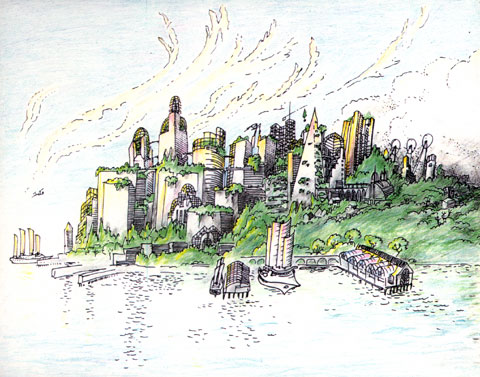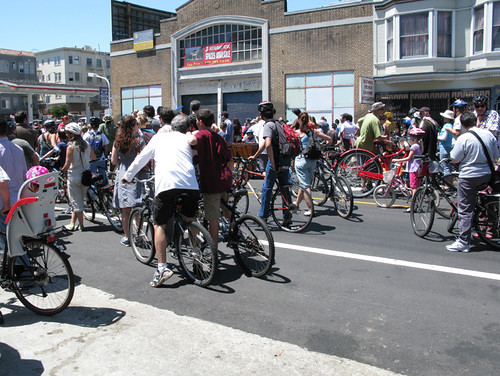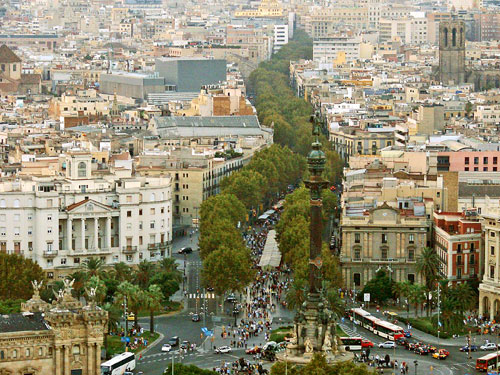Imagine an entity so big and powerful that it could conserve tons of energy and make a huge dent in carbon emissions. It might resemble a place you’ve seen before but wouldn’t recognize…

And imagine another entity shedding its drab fossil fuel suit, reappearing energized by the sun, clad in solar panels and rooftop gardens. It might look like this:

The entities I am talking about are, of course, Cities, and their role in shifting humanity from cheap energy gluttons to living within our ecological means must be nothing short of Super: The time has come for the urban Clark Kent to put on the green cape.
The last 50 years have witnessed a steep worldwide increase in the percentage of population living within cities, with a current global average of about 60%. This trend is predicted to continue, a fact that makes urban areas the single largest sources of carbon emissions contributing to resource depletion and climate change.
Thinking about cities as the solution to reverse global warming may seem counter-intuitive at first sight. After all, one would deduce that if cities are the largest sources of carbon emissions we would be better served by encouraging a “back to the land” strategy, hence reducing cities’ high carbon footprint. However, we all know that thinning out our cities would be the worst thing we could do in regard to climate change. In fact, we already tried that in the suburban experiments of the last half century, which made clear that the further we move apart from each other, the more fossil fuels we have to burn to stay connected.
So why is it that cities and the way in which we live in them hold the key to stopping global warming, and how do we get them to be a bigger part of the climate change conversation?
They say pictures are worth a thousand words…


.
.
.
..
.
..
Supercities tread lightly
Since the atmosphere doesn’t really give a hoot where the extra CO2 associated with our existence is released from, what it really comes down to is per capita carbon footprint. And behold, according to a study by the International Institute for Environment and Development, cities produce surprisingly low carbon emissions per capita, much lower than their countries’ national averages. For example, New Yorkers register footprints of 7.1 tons each, less than a third of the US average of 23.92 tons. And that’s including all the wasted electricity on Times Square!
It gets even better: According to Richard Register, founder of Ecocity Builders, redesigning cities in balance with nature could reduce their carbon emissions to 1/10 of its current levels. For example, if Washington D.C. were to be rebuilt from a sprawling car-centered to a high density public transit and pedestrian based city, its current annual per capita Greenhouse gas emissions of 19.7 tons of CO2 could be reduced to resemble those of Barcelona (3.4 tons) or Rio de Janeiro (2.3 tons). (See chart)
Let that sink in for a second:
A person living in Washington D.C. has 3 times the carbon footprint of a person living in New York City, 6 times the carbon footprint of a person living in Barcelona and almost 10 times the carbon footprint of a person living in Rio de Janeiro.
Two giants with different footprints
Since the Washington D.C. and Barcelona metropolitan areas are fairly comparable in population (5.3 and 4.9 million residents, respectively), let’s take a closer look at them: What strikes me most is that this ethereal little thing called Quality of Life doesn’t seem to be any lower in Barcelona than in Washington D.C. I mean, pumping out 6 times the amount of CO2 should get you at least some nifty benefits, like lower cost of living, better public services, or shorter commutes, right?
Well, the 2009 global city quality of living index gives Washington D.C. (100.3) and Barcelona (100.6) almost identical scores. Somehow you would think that a city burning only 1/6th of Washington D.C.’s fossil fuel would look like a shantytown, but looking at Las Ramblas, Barcelona’s central mall, you don’t get the impression that any modern urban amenities are missing:

However, if you compare it to Washington D.C.’s main drag, you immediately notice the defining difference between these two major metropolitan areas:

Yes, that’s right, everything on and around the Washington Mall is a lot more spread out than in Barcelona’s Las Ramblas, and not surprisingly, this stark contrast applies throughout both of these major metropolitan areas. Consider these numbers (gleaned from the two cities’ census data):
Washington D.C.: 3,722 inhabitants per square kilometer
Barcelona: 15,936 inhabitants per square kilometer.
Notice the correlation between population density and carbon footprint, how one city with 5 times the population density of another city emits only 1/6 of the carbon into the atmosphere, all at comparable levels of development and quality of living?
Wave hello to the elephants in the atmosphere
It is obvious then that there is huge potential to meet even the most ambitious targets to reduce greenhouse gases by rebuilding our cities into higher density areas based on access by proximity, such as better public transit systems, expanded walk- and bike ways, and more mixed use residential/retail infrastructure. And while the Washington D.C.’s of the world (a lot of them in the U.S.) have the potential for the most drastic carbon reductions, there is much room for improvement in cities around the globe, especially in developing countries where 90 percent of global urban growth now takes place: From minimizing the need for automobiles by building thriving city and neighborhood centers to better insulating existing structures and additions like roof gardens and tree planting, even cities with comparatively low emissions could make an additional huge dent in their carbon footprint.
Of course, this all seems to be fairly common-sensical, and you may even wonder why I bother to write about it. Thing is, if it were this obvious to the major players in the global climate debate that is about to culminate at the UN Climate Change Conference in Copenhagen we would hear much more about it. While most discussion in the run-up to Copenhagen seems to be centered around what targets of carbon reduction to set and how to set them, it would seem to make sense to also put a large emphasis on how to achieve those targets once we’ve set them.
For example, if we are going to shut down or drastically reduce dirty sources of energy like coal-fired power plants, we need to have a plan in place for how to live without them. Sure, alternative sources of energy like wind and solar are great, but why not focus on changing the 20th century urban infrastructure that causes us to waste so much energy in the first place? If the notion of reducing CO2 could be more strongly associated with economic and social opportunities instead of sacrifice, we could stop spending so much time and energy on haggling over targets and caps and get to work on building the infrastructure needed to thrive in a low CO2 world.
There’s no need to fear, Ecocities are here!
While I found one brief article entitled Cities hold the key to sustainability on the official Climate Summit site, I couldn’t find any workshops or panels that deal specifically with cities. However, there are other important efforts underway to develop an analytical and operational framework that can be used by cities across the globe to work towards their sustainability targets. Here are 3 organizations/programs developing specific proposals:
1. The World Bank’s Eco2Cities Program
“Eco2 Cities: Ecological Cities as Economic Cities” is a new program to help cities in developing countries achieve greater ecological and economic sustainability. The program will provide practical and scalable, analytical and operational support to cities. The program also aims to build a global partnership among forward-looking cities in developing countries, global best-practice cities, academia, and international development communities.
2. Ecocity World Summit in Istanbul
Ecocity 2009, December 13-15 in Istanbul, will bring together the architects, planners, designers, policy makers, green businesses, political and nonprofit leaders that shape the conversation around sustainable city planning. It will run parallel to and stream live feeds from the UN Climate Change Conference in Copenhagen, connecting the pivotal issue of ecological urban development to the overarching goal of reducing worldwide Greenhouse gas emissions. This year’s Ecocity Challenge is a special four-hour session where conference participants will begin to define internationally acceptable principles and metrics against which to evaluate the performance of ecocity projects worldwide. If you or anyone you might know is interested in joining together with an international community of inspired change-makers to come up with thoughtful and long-range solutions that are truly sustainable, ecologically healthy and socially just, you can register or get more info at http://ecocity2009.com.
3. Safe Operating Space For Humanity
Outlined by a working group at UC Santa Barbara’s National Center for Ecological Analysis and Synthesis (NCEAS), in cooperation with the Stockholm Resilience Centre at Stockholm University, these 28 internationally renowned scientists propose that global biophysical boundaries, identified on the basis of the scientific understanding of the earth system, can define a “safe planetary operating space” that will allow humanity to continue to develop and thrive for generations to come. The authors have made a first attempt to identify and quantify a set of nine planetary boundaries, including climate change, freshwater use, biological diversity, and aerosol loading.
The Spidercity web of life
 What I like about cities and why I think they are so vital in the climate change discussion is their innate diversity and complexity, both culturally and physically, reflecting the diversity and complexity of the earth’s ecosystem. If we can manage to live in harmony with nature in our most densely populated human settlements, we’ll be well on our way to living in harmony with our entire planet. What we do in our cities ripples throughout the globe. Each person moving closer to their workplace is one less car purchased and driven and 3000 pounds less steel, iron, rubber, plastics and aluminum extracted from around the world. Each vegetable grown in a rooftop garden is one less vegetable transported thousands of miles to a city dweller’s dinner table. Cities truly are the thermometers of the world’s environmental well-being. If cities are healthy, the earth is healthy.
What I like about cities and why I think they are so vital in the climate change discussion is their innate diversity and complexity, both culturally and physically, reflecting the diversity and complexity of the earth’s ecosystem. If we can manage to live in harmony with nature in our most densely populated human settlements, we’ll be well on our way to living in harmony with our entire planet. What we do in our cities ripples throughout the globe. Each person moving closer to their workplace is one less car purchased and driven and 3000 pounds less steel, iron, rubber, plastics and aluminum extracted from around the world. Each vegetable grown in a rooftop garden is one less vegetable transported thousands of miles to a city dweller’s dinner table. Cities truly are the thermometers of the world’s environmental well-being. If cities are healthy, the earth is healthy.
Lastly, and most importantly, I believe that the climate change debate cannot and must not only be about numbers. While it’s important for the big macro policy debates to negotiate emission caps and target decimals, we need to do a much better job at bringing the issue closer to home, to explain the solutions in terms that people and communities can understand and get behind. Being able to talk to your neighbor or make a spontaneous stop at the ice cream shop is a much more compelling argument for people to remember how much they like bicycling than the abstract concept of getting below 350ppm of carbon dioxide levels. Closing down streets to cars and having merchants realize that all the foot traffic actually increases their business does more to change hearts and minds than reports of melting glaciers. Tasting a delicious tomato from your own backyard — not a U.N. brief on the dangers of global warming — will turn those who aren’t already into stewards of the earth.
We have to rediscover the joy of living simply, of sharing space and resources, of finding and creating community in our daily acts. The more and the quicker people realize that what we’ve come to consider as wealth is mostly waste, the better prepared We the People will be to live happy and fulfilling lives in a post carbon-intensive world. After a century of extreme expansion, Mother Earth is asking us to move closer together, not only to physically survive but to find renewed meaning in our existence on this beautiful planet. She’s asking us to come out of our (car)shells and talk to each other, to gather in public and look out for one another. And what better place to do that than in a vibrant, pedestrian-friendly, superhero ecocity?
I’ll leave you with a rerun of a video I put together a little while ago…
=======








[…] Standards, Richard Register, urban planning Some of you may be familiar with my diaries about ecocities. From Venice and Istanbul to West Oakland, I’ve written about urban areas within an ecocity […]